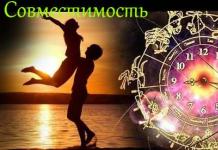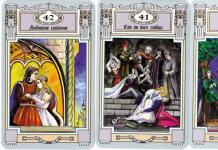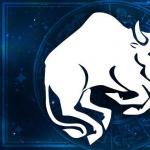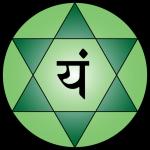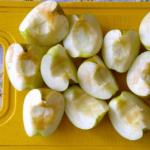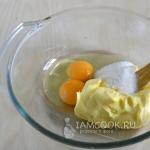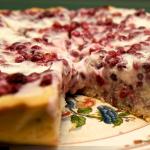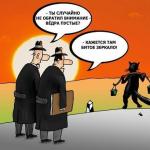People prefer one deck over another for two reasons. Some people choose a specific deck simply because they like the illustrations, while others are looking for a figurative system that is closest to them, for example, they prefer images of gods and goddesses of the ancient Egyptian, Celtic or ancient Greek pantheons.
Ceremonial Mages most often focus on traditional Tarot correspondences associated with the teachings of the Hermetic Order of the Golden Dawn. Today this system is widely known.
Magical Tarot of the Golden Dawn by Sandra Tabatha Cicero
This deck is based on the traditional teachings of the Hermetic Order of the Golden Dawn. The Major Arcana cards are filled with symbolism and imagery, while the Minor Arcana cards, as was customary in the so-called “medieval decks,” are numbered and executed in a conventional artistic manner.
Aleister Crowley's Tarot of Thoth
The Thoth deck is also based on the Golden Dawn's teachings on tarot cards, although modified according to Aleister Crowley's system of Thelema. The cards were created by the magnificent artist Lady Freda Harris.
Universal Tarot by Roberto de Angelis
This tarot deck is a new version of the Rider-Waite Tarot, the most popular deck of all time. The deck retains the original images by Pamela Coleman-Smith, but the lines of the drawings are softened, the style is modernized and looks more natural.
Babylonian Tarot by Sandra Tabatha Cicero
This deck combines the familiar attributes of the Golden Dawn with the imagery of Ancient Mesopotamia.
Tarot de Marseille (version published by Lo Scarabeo)
The most popular of the "medieval decks", it dates from the 18th century and became the model for many decks that came after.
Many traditional tarot decks are based on the attribution developed by the Golden Dawn. However, even between traditional decks there are significant differences in keywords, design and imagery, which naturally influence the choice of a particular card as a talisman. The same card from different decks can be used for different magical purposes.
So, Arcana Lovers associated with the zodiac sign Gemini and is suitable for invoking any of the qualities inherent in this sign of mutable Air, versatility, communication skills and ingenuity. But at the same time, the system of images of the Arcana Lovers in each of the five decks listed above suggests different purposes for its use. For clarity, here is an example of such different goals.
- Magical Tarot of the Golden Dawn: to gain victory over insurmountable obstacles or free yourself from something that binds you.
- Tarot of Thoth: to successfully unite opposites and achieve harmony.
- Universal Tarot: Helps to realize the sacredness of sexual union or to better understand the spiritual concept called the Garden of Eden and its meaning for an individual.
- Babylonian Tarot: to learn how to become a more attentive and loving partner.
- Marseille Tarot: to ensure a successful marriage.
As another example, consider a card from the Minor Arcana, Six of Swords. The unique system of images of this card in each of the five decks has a very wide range of applications.
- Magical Tarot of the Golden Dawn: to find stability after a period of conflict and struggle.
- Tarot of Thoth: to achieve complete balance or make a qualitative breakthrough in the scientific or technical field.
- Universal Tarot: to move forward after a long negative period.
- Babylonian Tarot (here this card is called the Six of Arrows): to heal after a long illness or to become a healer.
- Tarot de Marseille: Since the Minor Arcana of this deck are stylized and numbered, the Six of Swords will work for any of the purposes listed above.
As you can see, each Tarot card has a specific purpose, and the purposes may vary depending on the type of deck. About and about, you will learn in the following articles.
Modern Tarot card decks not only have magical powers, but are also incredibly beautifully designed - when you go to the store, you can stumble upon the most incredible types of Tarot card decks. But many experts agree that for each person there is only one deck that is exclusively suitable for him. Decks of Tarot cards are radically different from each other, and each has its own special detail that has its own meaning and power. However, there are decks of cards that do not have magical powers, but look like a real work of art: they are beautifully designed, but the symbolism may not be observed in them, and they, in principle, are not entirely suitable for fortune-telling rituals. But still, just for fun, it’s worth learning about several of the most beautiful Tarot decks.
Tarot fortune telling
Fortune telling using Tarot cards is one of the most ancient means of forecasting. Each card, in combination with others, has its own meaning, according to which the magical prediction is interpreted. The cards accurately answer any correctly posed question; they will help you look into your own past, future, and into someone else’s secrets. By turning to the cards, you can find out almost any information, for example, precise directions or get an answer to a worrying question.
Before starting fortune telling, you need to clearly formulate your question (you can ask it to yourself), because each of the cards has a basic meaning, but can be interpreted differently, depending on the general context. The combination of the cards drawn together gives a more accurate and truthful answer.
Tarot schools
There are four main schools of Tarot. Each school has several decks that belong exclusively to it. They differ in the interpretation and symbolism of the minor arcana, in the spelling of words, layout methods and, in principle, the process of fortune telling.
- Aleister Crowley school
Manipulations with decks from the Aleister Crowley school should be carried out quite carefully; according to the rules, you cannot ask unimportant questions and perform rituals too often. Energy is drawn from your field and requires a lot of concentration. According to the theory of this school, the entire ritual occurs solely due to a person’s own thought processes and his subconscious. The decks use symbols from astrology, numerology and Kabbalistic movements in abundance.
- White school
White's school is distinguished by its depth and complexity of storylines. Because of this, cards are often interpreted in their own way by a fortuneteller, and this is permissible by the rules. To understand more strict meanings, you can use the interpretations of the order. Also, the fortune telling process does not require special rituals, and you don’t have to be afraid of the blowback.
- Marseille school
In the Marseille school, fortune telling does not require special rituals, and as for the decks, the minor arcana are distinguished by simple and laconic designs. The cards have virtually no hidden meaning; there are no mysterious meanings or symbols in the images.
- Papus school
The Papus school is not very different in general principles, except that it makes extensive use of decks with Kabbalistic symbolism.
Tarot of Aleister Crowley or Tarot of Thoth
The creator of the Thoth Tarot deck, Aleister Crowley, is worth highlighting separately; he was truly an extraordinary person. His school uses the fewest decks, but at the same time they are the strongest, this can be noticed even because of how great the differences are. His deck obeys the mind on a subconscious level; it feels a person. It is difficult to find a card more complex and rich in small details, esoteric and occult, Kabbalistic signs. He wrote an entire book to create his Thoth deck. It is thanks to such a supernatural combination that Aleister Crowley's cards to this day form the most mysterious and beautiful Tarot decks of all.
There are also several specific decks that are not included in any of the traditional European schools.
What are the types of Tarot cards?
We have already figured out that each deck belongs to a specific school, which determines the general rules of the plot depicted. Let's look at these parameters in more detail. Tarot cards are traditionally larger in size than playing cards (from which they originated). The cards are further divided into suits: Arcana, zodiac signs and the designation of any symbolism.
There is an opinion that a lot depends on the technique of drawing maps. Dark tones with ominous designs reflect more evil energy, which only a professional or an energetically strong person can handle. Light, warm and calm colors are recommended for those who are just starting out and want to experience the effects of the cards. In any case, each deck is individual, and a person will feel the deck intended for him simply by picking it up.
Tarot Arcana and Zodiac Signs
First of all, the deck is divided into the Major Arcana (22 cards) and the Minor Arcana (56 cards, 14 of each suit). The Major Arcana are absolutely independent and denote individual elements, but in combination with other cards from the layout, a specific interpretation acquires a more detailed answer.
Arcana are divided into 4 suits:
- wands (otherwise known as Staves);
- cups (Bowls);
- swords;
- Denarii (or Pentacles).
Each zodiac sign has its own cards, which most closely reflect the essence of their inherent human nature. Usually one of the Major Arcana cards corresponds to a zodiac sign on the principle that they best describe a certain character of human nature.
Magic attributes
The attributes mainly depend on the suit of the card, since the suit must be the main subject in the composition of the cards of the Minor Arcana. For example, as a symbol for Swords in the Ostara tarot deck, these are either blades stuck into a tree or a sword piercing a skeleton.
The gentle Ostara tarot deck celebrates the feminine. The woman is shown as a force of prosperity and spring, and many cards depict the tender embrace of people and animals. The deck contains many elements of nature, and not only plants or animals are used, but natural signs and phenomena. The deck is made in warm, pleasant shades, and many traced details make it even more interesting. A special difference in the design is the depiction of moonlight and sunlight, creating a magical atmosphere.
Rare tarot decks

Listed here are Tarot decks little known to the general public, which fascinate with their beauty and symbolism.
Shakespeare Tarot
Lyricism, drama, romanticism - these are the main features of Shakespeare’s works and, at the same time, of human destinies. That is why his works best reflect the twists and turns of life's journey.
The true essence of the deck can be understood by people who are closely familiar with the works of the playwright. Each suit is built on the basis of one of the works, with which the unity of meaning and spirit is felt. Cups symbolize the storyline of Romeo and Juliet, echoes of Pentacles can be found in Othello, and Swords in Macbeth.
The symbolism depicted on these cards should not be interpreted according to the generally accepted concepts of the order; it is better to rely on the meaning that Shakespeare himself gave to them. Each card depicts characters and scenes from one of the works. Based on its plot, you can understand what fortune telling is telling you. At the top, under the number, the names are signed so that the fortuneteller does not get confused and, in case of ambiguity, clarifies the fragment.
Everything is done in the same style, each stage is framed as if by a frame or theatrical scenery with columns and skillful stucco. Against a faded blue background, bright suits and dresses look fabulously magical.
Decks V.A. Sklyarova
The artist Vera Anatolyevna Sklyarova also created several decks with similar occult themes: “Tarot of Shadows”, “Fairytale Tarot”, “Tarot of Dante’s Divine Comedy”.
Deviant Moon Tarot (or Crazy Moon Tarot)
Speaking of beautiful tarot decks, first of all it is worth mentioning the enchanting Deviant Moon Tarot deck. Its design seems to cross the works of Tim Burton and Hieronymus Bosch. Dark and frightening creatures, against an equally frightening background. The images contain many references to the Middle Ages, and to the cruel Middle Ages at that; sometimes ancient motifs are also found among the decks.
White skin, otherworldly eyes, elements of animals and fantastic creatures (wings, tails, paws), multi-armed, two-faced characters, devils and angels, puppets - these are the key characters of the Major Arcana.
The suit of Wands is based on a green-brown color scheme, similar to the element of earth. Each card depicts sticks, wands, and torches in a different role, and here the author’s imagination can only be envied. The beams on which the leafy house stands, the staircase railings, the stilts, the scythe, the murder and gardening weapons - and every element is thought out. What is demonstrated here is not just a variety of details, but every detail, every wand is directly related to the character depicted on the card.
The cups are part of an eternal, continuous feast and celebration that sometimes turns to sadness. In this suit, Cups are only an accessory to many scenes. They always have different content, they serve different roles and different characters. These characters are as unusual as those depicted on the cards of the Major Arcana. Blue, red, and purple shades prevail here in clothing and details.
The Suit of Swords are made in the red and gold shades of the royal robe. Fighting, destruction, death, suicide, tricks - all the functions of the sword are demonstrated in tandem with the same incredible creatures. Their faces and bodies are frightening, this can directly affect fortune telling. The dark power of the cards is reflected in the tones and shades; it is highly not recommended to use them for a person with a shaky nervous system or a novice in fortune telling.
Other beautiful tarot decks
Considered one of the most beautiful decks Tarot of the Valley of Mirages. Delicate, flying, incredibly airy scenes, made in watercolor, and at the same time with the drawing of the smallest details - like a stream of wind concentrating at a single point, where the main drawing of the card symbolism appears. Tarot of the Valley of Mirages has no name or frame; with the help of this deck you can not only guess, but peer deep into a person, into his talents and destiny.
Small touches in the deck Wildwood Tarot The world of our ancestors is depicted. Nature appears in all its grandeur with the changing of seasons and the elaboration of each leaf. Rich colors, characteristic characters, objects characterizing their activities, shamanic accessories. Although the color scheme is rather dark, it is by no means intimidating, and each card has a neat signature at the bottom.
A very distinctive style is demonstrated in Paulina Tarot, similar to an 18th century illustration for a children's fairy tale. Angular suits, elongated limbs, good nature and elegance. The pictures seem to depict revived flowers, transformed into brave horsemen, skilled magicians and majestic empresses.
Alchemist's Oracle— an oracle made in black and white colors with bright elements. What is striking is the simplicity, so unusual for such a subject, the graceful geometry of the lines, the dotted flashes of color, transforming into a rainbow symphony. This is not only a modern, but also an incredibly beautiful Tarot deck, but devoid of the influence of the dark forces of the past. And who knows whether this affected her magical properties for better or worse.
They often release decks on a specific theme, sometimes not even related to any area of magic. Such cards cannot be called suitable for fortune telling, however, they are beautiful as an object of art, for example, "Klimt's Golden Tarot".

Separately, it is worth noting the beautiful antique deck from the 1890s Grand Etteilla Tarot. It is made in a very romanticized Middle Ages style with a clear touch of minimalism.
Deck Prisma Visions Tarot looks more than unusual. It is very distinguished by the general color scheme, a dark blue background, but not at all frightening, but rather deep and awakening. On it, small splashes and lines are made of drawings reminiscent of Van Gogh’s works, for example, “Starry Night” and “Starry Night over Ronoi”. The quintessence of orange and yellow colors, absorbing blue, green, red. The maps depict people against the backdrop of nature, people on a par with nature, people under the influence of nature.
Each Tarot deck appears before the eyes of the audience as very special and unlike anything else. Their beauty is determined only by the personal preferences of the fortuneteller and the purpose of magical rituals. Many people prefer cards that have artistic or historical value, but we must not forget that this is an object related to the other world, and it has its own power.
The deck itself chooses its owner, you will feel attracted to the one that was created for you. It is very important to choose a deck that does not cause rejection, otherwise it can lead to disastrous consequences. And be careful when choosing your style and overall tone—dark, ominous cards need to be handled well.
And, in conclusion, a video review of the elegant Polish Golden Tarot deck
"...The deck is simply amazing, with a bright and lively character. Quite cynical, loves to joke or ask a riddle, but at the same time accurately answers questions. Yes, it is specific - after all, the Black Demonic Tarot. You will not turn to it with everyday problems, but on issues of magic, on shadow influences, there is no better option. She explained the situation to me when I was at a dead end, helped me out of trouble a couple of times, and through me she works well with those who are in contact with me. , gives very complete and accurate answers. She opens those corners of your soul that you are afraid to delve into, she puts before you those problems that you are afraid to solve, and you can’t argue with her. At the same time, she always not only describes the situation, but also gives advice. how to get out of it.
Regular layouts won't work with it either. When communicating with the Tarot of Shadows, you need to listen to your intuition and tune in to the deck. She will allow you to pull out exactly as many cards as you need; if you get impudent, she will say a lot of nasty things and close for a while. The easiest way is to ask the deck questions and draw cards - as many as it allows.
The meanings of the cards, of course, are not standard, like the entire deck as a whole. The Major Arcana have a meaning opposite to the classical one, aimed at identifying shadow aspects and, in general, magical actions. The Minor Arcana are also costumed, so the deck is quite easy to read. At the same time, the Minor and Major Arcana are approximately equal in importance; they are difficult to separate. The deck is generally perceived as a single whole.
The cards are based on plots from the field of classical demonology and mythology. In principle, the deck is very interesting to get acquainted with. The color scheme is strict - as if pencil sketches on a white background. The back of the deck is red, in the center is an inverted pentagram with the head of a goat inscribed in it.
At first, the deck will test you, as if a chill comes from it, you can feel the breath of the abyss. But if you pass the test, she will soften. It is very important to find a common language with her and not disturb her over trifles.
To work with the Tarot of Shadows, you need to have strength and will. Such a deck may well enslave, and it will also not forgive if it is put in second roles. It should be on par or higher than other decks. The deck demands respect.
Tarot of Shadows always requires payment for its services, it siphons off energy at a high rate - but it’s worth it to get answers from it.”
Fulmira
"... I developed a very strange relationship with this deck. It all started with disgust. Yes, exactly with disgust. When I first saw this deck in the White Clouds, I felt disgusted. Strange plots. Anger, envy, lust. All dark side on them. However, over time, inevitably meeting her, I began to take a closer look. And the cards began to take on colors, the pictures became more vibrant. And then for the first time I spoke to them In their language. I asked questions, argued, proved something. And the cards answered me. Often, they are rude, quite personal. And at first glance, the deck itself resembles a little mischievous imp. If you ask them an incorrect question, in their opinion, it begins. undisguised rudeness. Moreover, it continues if you insist. However, with sufficient flexibility, the answer to the question is quite possible. At the same time, you will learn to formulate questions correctly.
The cards answer, contrary to popular belief, not only questions about the dark side. They have enough symbolism to describe the whole situation, not just one part of it. There are also limitations, but with experience with the deck they become less and less. Another prejudice: this deck eats a lot when doing fortune telling. It is not always so. IMHO, no matter how you place yourself with her, so it will be. If you let her eat, she will eat. If you communicate with her as equals, there will be no problems.
In any case, “Tarot of Shadows” is not the child that it seems at first. If in the first months of acquaintance you do not begin to be afraid of her, feel reverence or similar nonsense, the deck will open up and it will be quite possible to work with her. The character is complex, but with respect, the result of teamwork can be wonderful."
Con Lliar
Of course, the choice of Tarot deck is individual, and a lot depends on your tastes. However, if you seriously intend to learn the art of prediction or study the Tarot as an encyclopedia of occult symbolism, you should opt for one or more serious decks that carry a whole history of the development of philosophical thought. How often is it difficult for a novice tarot reader or adept of magical science to understand which deck is worth his time and money and which is not.
After all, the choice is huge, and the resources are not unlimited. Moreover, I would like to begin to understand the Tarot, if not immediately, then after several months of study. There are decks with which this is simply impossible. But first, I'll tell you what's important in decks. Of course, I will not be able to describe all the existing versions of the Tarot in this article, but after reading you should have a fairly complete idea of what they are like.
Briefly about the method
Each of the major arcana of the Tarot is an archetype, a collective image of a force or energy that causes certain changes in your life. Images of earthly and divine parents, the shadow side of personality, inspiring or terrifying images of sexual partners, as well as various signs and symbols of good and bad luck, movement and stagnation, separation and unification - all this relates to the depths of our psyche. Ideally, a Tarot layout is a photograph of a person, his personal history, mentality and an indication of his prospects in this regard. After all, there is no future whose roots are not in the past. And there is no situation that is not indicated in one way or another by some signs, be it in a dream, a vision or an answer from an oracle.
 The minor arcana of the Tarot can be compared to the Book of Changes, the I-Ching. They contain signs of a particular situation. Situations follow one another, but if you follow them long enough, you will notice the repetition of situations. The minor arcana are almost an exact copy of a deck of playing cards, with the help of which you can also predict fate, but this prediction will be quite flat: there will be not enough depth and an answer to the question of which archetype dominates the situation.
The minor arcana of the Tarot can be compared to the Book of Changes, the I-Ching. They contain signs of a particular situation. Situations follow one another, but if you follow them long enough, you will notice the repetition of situations. The minor arcana are almost an exact copy of a deck of playing cards, with the help of which you can also predict fate, but this prediction will be quite flat: there will be not enough depth and an answer to the question of which archetype dominates the situation.
Each Tarot deck also contains 16 face cards representing people. The meaning of these cards is considered the most complex. On the one hand, they depict a person who is involved in the situation. On the other hand, they can indicate the character traits of the person being told fortunes. These qualities can help or hinder him on his path, depending on the color of the minor arcana.
Truly valuable Tarot decks are distinguished by the fact that they have a strictly ordered system of interpretation. Interpretations are not taken out of thin air and the imagination of the author, but are derived from a finite number of symbols and signs.
In the “correct” decks, all these signs are marked on the cards and help at one time or another during practice to see one of the necessary symbols and apply them in interpretation. The word “correct” is in quotation marks because, on the one hand, almost every magical or tarological school considers only its interpretation to be correct, and on the other hand, each drawn deck has the right to exist within its own boundaries - either for meditation or for personal understanding its author.
 In the “correct” decks, each card corresponds to one of the five elements (elements), one of the seven planets and/or a zodiac sign. Each major arcana carries the same information as a deity, which can be found, if desired, in each of the pagan pantheons of antiquity and even in monotheistic religions in the form of the names of god, angels and saints. Therefore, the major arcana have only one meaning: in front of us is either a planet, an element, or a zodiac sign. All these keys are contained in the Rose Cross of the Rosicrucians.
In the “correct” decks, each card corresponds to one of the five elements (elements), one of the seven planets and/or a zodiac sign. Each major arcana carries the same information as a deity, which can be found, if desired, in each of the pagan pantheons of antiquity and even in monotheistic religions in the form of the names of god, angels and saints. Therefore, the major arcana have only one meaning: in front of us is either a planet, an element, or a zodiac sign. All these keys are contained in the Rose Cross of the Rosicrucians.

And here is an image of the Rosy Cross, containing all the keys to the Tarot and the occult tradition. On the cross, the central rose consists of petals with one of the letters of the Hebrew alphabet. The Kabbalah is another way of interpreting the Tarot, and knowledge of it is contained in the Sephiroth of the Tree of Life.
Each face card (or court card, as they are also called) is a combination of two elements - for example, fire and air, water and earth. In the best decks, the minor arcana correspond to the planets in the zodiac sign and element.
Tarot card images must take into account correspondences with the elements and planets. They must be of the appropriate color, and their heroes must bear symbols that correspond to the gods of one or more pantheons.
Best decks
Aleister Crowley or Rider-Waite?
Aleister Crowley's Thoth Tarot deck is a treasure trove of symbols. Compared to other decks, there is much more detail in its major arcana. Its study may take many years, but in the art of prediction you will advance further than those who use simpler decks. You will not depend solely on intuition or the grace of the gods to show you the right cards. You will know their exact decoding. But the deck is certainly not suitable for those who do not want to delve deeply into the nature of the Tarot. This is not a toy or entertainment. The deck holds secret keys to human abilities, and if you are looking for Tarot to just want to tell your fortune at Christmas time, do not take it.

The Rider-Waite deck is also a useful tool for fortune telling and the study of symbolism, and many tarot readers choose it exclusively. In any case, in the depiction of the major arcana, every detail of the image of the central figure carries a symbolic meaning, although there are many orders of magnitude fewer such details than in Crowley.

It is also difficult to trace the system in the interpretation of the minor arcana. For Waite, it is based on a system of fortune telling using ordinary playing cards, while Crowley correlates his minor arcana with the planets in the zodiac sign, calculates the cabalistic meaning, and gives the corresponding hexagrams from the I Ching and geomantic signs. Although the system seems complex at first glance, in the end it is more orderly and logical.
Tarot of Papus and Oswald Wirth
These decks have a different, but rather logical system of correspondences from the previous two decks and, in general, displays important aspects of the archetypes that are embedded in the idea of each of the arcana. They contain quite a lot of symbolism, details, symbols that will help to understand them not flatly and specifically, but in a general way, in order to grasp the meaning for a person of the idea that stands behind them. Several times I have heard the opinion that the predictive power of these decks is quite high. Difficulties can arise only when correlating these cards with Hebrew letters. Also, the numbering of the arcana raises some doubts, but, in theory, this should not greatly affect the predictions.

Decks that are interesting at a certain stage of learning
Marseille Tarot
Drawn quite simply and flatly (there is clearly a lack of color palette), the deck is useful for studying the Tarot as a worldview system for humanity. Without the Tarot of Marseilles, it will be difficult to understand the history of the deck, which slowly but surely changed, without the Tarot of Marseilles, which is an intermediate link between the oldest decks from the time of Visconti and the more modern Papus and Waite ones. However, it is unlikely that it will be possible to fully understand the system of Tarot symbolism and learn the art of prediction from scratch using only this deck.

Tarot of the Order of the Golden Dawn
Suitable for those who are determined to study Jewish-Egyptian magic and Kabbalah. The deck is a reflection of the worldview described in the book by Israel Regardie, “The Complete System of the Order of the Golden Dawn.” It was from this deck that Aleister Crowley drew inspiration when creating his own, although the decks are not very similar to each other. More suitable for the study of symbolism than for prediction. The problem with this deck is that there is little literature on its interpretation, so the decoding of some symbols remains a matter of guesswork.

Tarot Visconti-Sforza
One of the oldest decks that have come down to us. They say that it was assembled from several Milanese decks that were in circulation during the reign of King Visconti. He himself ordered one of them from the artist. The deck contains some important keys that help you better understand the meanings of each of the major arcana.

Tarot Liber T “Stars of Eternity”
Those who like Aleister Crowley's Tarot of Thoth will be interested in studying this deck. The major Arcana are depicted here in less detail, but the minor ones are beautiful because they tell a certain myth that can be useful for their understanding. It is difficult to use this deck for fortune telling, because the interpretation of the minor arcana is not always limited to the myth they tell, but it is very advisable to know it and keep it in mind when using the Thoth Tarot.

Tarot Lon Milo Duquette
This is a deck not for fortune telling, but for magical rituals. In addition to some additions to the symbolism of each arcana, this deck is especially necessary for those who practice Enochian magic, as well as other evocations of spirits, as it contains a system for combining Enochian tablets and spirit sigils with Tarot cards.

Russian Tarot, Egyptian Tarot, Italian Tarot
We see in these decks a pursuit of stylization, which harms the information content of each of the arcana, but this group of decks deserves a few minutes of our attention (provided that the symbolism of the Tarot is already well known to us).
Indeed, the image of Ivanushka the Fool from the Russian Tarot is close in meaning to the Jester from the Thoth Tarot, but this is only one aspect of the idea contained in the lasso. If we are talking about the Egyptian Tarot, then Thoth really perfectly corresponds to the idea of the Magician card, but, firstly, other meanings and ideas that it contains are lost (and which are well revealed if we study several serious decks at the same time), and secondly secondly, the opportunity to combine symbols inherent in the gods of different pantheons is lost.

The most useless decks

"Frivolous" decks
Tarot of gnomes, angels, witches, vampires, etc. In such decks, in pursuit of style, the very versatility of the symbols is lost. Each of the arcana may have only one coincidence with more serious analogues, or may not have it at all. For example, an angel on a card from the Guardian Angels Temperance deck can pour white liquid from one vessel to another, and on the Justice card there will be scales, as in serious decks. But all other matches will be lost.
The fact is that these decks cannot be true: in the Tarot there are simultaneously gnomes, witches, and angels - but they are not the main characters, but only accompany secret and multifaceted symbols, which are best depicted in the form of human figures ( as in Waite and Visconti) or in the form of impersonal deities (as in Crowley). The main thing in the Tarot is an archetype that can be described with the help of symbols, and no dwarves themselves are able to do this without leaving a trace of their “dwarven” energy, if such is even possible.
 Standing a little apart are such decks as Madame Lenormand cards, Osho Zen Tarot, Tarot Manara, as well as many designer decks. The fact is that at one of the degrees of initiation, each magician must draw his own deck. There are too many designer decks to list here. Lenormand cards and most of the author's decks are more like solitaire for fortune-telling, rather than a serious generally accepted (at least within one of the schools) system of correspondences. In principle, you can tell fortunes using coffee grounds, animal entrails, and Lenormand cards. But fortune telling on the Osho Zen Tarot is hardly possible. These are more of a meditation card. The only thing we don’t know is why such cards are called Tarot?
Standing a little apart are such decks as Madame Lenormand cards, Osho Zen Tarot, Tarot Manara, as well as many designer decks. The fact is that at one of the degrees of initiation, each magician must draw his own deck. There are too many designer decks to list here. Lenormand cards and most of the author's decks are more like solitaire for fortune-telling, rather than a serious generally accepted (at least within one of the schools) system of correspondences. In principle, you can tell fortunes using coffee grounds, animal entrails, and Lenormand cards. But fortune telling on the Osho Zen Tarot is hardly possible. These are more of a meditation card. The only thing we don’t know is why such cards are called Tarot?
Tarot of Hieronymus Bosch, Sandro Botticelli, etc.
These decks don't work at all. They are even worse than the previous type, because modern compilers simply took them out of the paintings of various characters and placed them on the lassos. For example, the real Pope from Botticelli’s painting “The Temptation of Christ” migrated to the Hierophant (High Priest, Pope) map. Venus from the painting “Birth of Venus” - on the Empress card. But Tarot is different in that color matches and various details are important. If Bosch or Botticelli painted their popes and empresses without wanting to compare them with certain arcana (often their goal was to ridicule a certain person in power or talk about an impending coup), then the Tarot from such pictures simply will not work. After all, in the Tarot there are not specific popes and empresses - they are collective images that carry such depth that can never be represented by a specific person. Well, in general, artists who draw Tarot at least think about the Tarot and the symbolic figures that need to be depicted, whereas in the case of artists’ Tarot, ready-made figures are pulled onto the lasso (read - pulled by the ears).

The exception is Giger's Tarot, who, in any case, participated in the creation of the deck. But this deck is too specific and is hardly suitable for everyday use.
Sequence of studying maps
First, I recommend familiarizing yourself with the Rider-Waite Tarot. It is the most popular, and you have probably already seen it. Then it makes sense to look at the Visconti-Sforza Tarot to see that the Tarot has its own unique history. Then you should purchase Aleister Crowley's Tarot of Thoth and books on its interpretation and delve into the history of occult symbolism. After a fairly intense strain of your brain and putting the symbolism of the Tarot into a certain system, you can quickly study all the other Tarot decks (except for the most useless ones).
After some time, you will see for yourself how well you can distinguish serious decks from frivolous ones, useful from useless ones, and also decide which system of correspondence and school of interpretation is closer to you.
Do you want to start reading Tarot cards, but don’t know which deck to choose? In this article we will tell you about what decks of Tarot cards there are, how to classify them, etc. Enjoy reading!
Ways to classify Tarot cards
Before choosing Tarot cards for fortune telling, you should consider how they are classified.
All existing Tarots are divided into three main categories:
- Maps made taking into account the traditions of different schools (Papus, Waite, Marseilles, Crowley)
- Purpose (specialized, universal)
- Thematic focus (fantasy, animal, dark decks, etc.)
To find out which Tarot cards are the most powerful, let's look at the features of their creation in the four main traditional schools. Each of them is a separate divination system with its own characteristics, differences, and similarities.

Papus Tarot School
According to the traditions of this school, Papus's maps have the following characteristics:
- Number eight - Arcana Justice
- Number eleven - Arcana Strength
- Zero or twenty-first number - Arkan Jester (analogy of the letter Shin, shape resembles a fork)
- The first letter Aleph (Kabbalistic alphabet) - Magician
- Image of the Arcana of Lovers - a young man is between two women (possibility of choosing a future betrothed)
The reason for this interpretation of the deck lies in the following - the founder of the Papus school argued that successful fortune telling is carried out by connecting the goddess Isis, the patroness of the Tarot, to the egregor.
Marseille Tarot School
The main feature of cards made in this tradition is the unique design of the cards. See details below.
- A small selection of colors used - in the illustrations of the Arcana there are shades of beige, red, blue, yellow
- Blurry images, lack of detail, rough outlines in drawing the Arcana
Examples of popular cards associated with this school are Tarot of Angels, Tree of Life, Tarot of Marseilles
Years later, followers of the Marseille school began to publish other types of artistic decks with non-standard designs.
Waite Tarot School
It is one of the most common in modern society. All the meanings of the Arcana have an astrological background.
Main differences and features from the above traditions.
- Number eight - Arcana Strength
- Number eleven - Arcana
- Zero or letter Aleph - Jester
- Betts - Mage
- Arcanum Lovers - a man and a woman walk in the Gardens of Eden. Another image option is a couple's wedding
Crowley Tarot School
The Thoth deck belongs to this tradition - one of the most powerful Tarot cards. The unique design of the arcana images immediately catches the eye - it cannot be confused with any other deck.
The differences and features of the above cards are three types of illustrations of the Arcana Magus (Indian, Greek, Egyptian). The second version of images is considered the most common.
Important point! Only professional tarot readers can work with these cards and only on very important issues. When pulling out the required number of cards, ONLY your LEFT HAND should be used! Correct interaction with allows you to enter a meditative trance and better understand your own inner world!
Universal and specialized decks

We offer a list of popular universal, specialized Tarot decks (for fortune telling for certain situations - love, work, finances, etc.).
Universal
Rider-Waite deck
One of the most popular decks for beginners. An intuitive image and simple interpretation are only part of the advantages of these cards. Thanks to its wide range of actions, you can use it to get answers to all your questions, regardless of the current problem.
Small Lenormand deck
Oracle is perfect for beginners. It will allow you to feel the depth of the symbolism of the images. The interpretation is accessible even to those who picked up the deck for the first time. Contains 36 cards.
Specialized Tarot
Dwarf Cards
It is used exclusively to obtain answers to material or everyday questions. The deck is based on the gnome character Siken, who travels the world. Each card is a story from his adventures.
Tarot Manara
Allows you to make readings on questions of a very intimate nature. The Arcana are full of explicit images, so they are not suitable for everyone. It carries feminine energy, so it is not recommended for men.
Lovers Deck
Gives answers to questions related to the love sphere. The pictures are not made in an overt erotic accent (as in the previous case). The symbolism of the Arcana is more gentle and romantic.
Tarot of Shadows
A very specific deck that takes some getting used to. Using these cards, you can diagnose the presence/absence of magical influences and obtain comprehensive information about what to do in the current situation.
Thematic Tarot Decks
Let's consider several options for thematic decks. Let's start with the darkest ones.
Tarot of Demons
The cards can be regarded as basic or additional to the Tarot of Shadows. The composition includes not only images of demons, with their own energy, but tarot readers without experience are categorically contraindicated from working with it. The reason is simple - it will be difficult for a person with a lack of personal experience to interact with her. The interpretation of the meanings is similar to the classic Rider-Waite deck. Determines the negativity imposed on a room and/or person.
Black Grimoire (Necronomicon)
One of the most common “dark” decks. Due to the waywardness of the character, it is not suitable for every person. Having bought these cards, be prepared for the fact that they will reveal everything hidden in the depths of your subconscious. When doing fortune telling, you should be vigilant, careful, and careful so as not to “anger” them.
Tarot by Paolo Martinello
A very picturesque deck, the Arcana of which are depicted in the form of pegasi, dragons, witches, gods, and other inhabitants of the magical world. The myths of medieval Europe were taken as the basis for creating the symbolism. Serves as a full-fledged alternative to the Rider-Waite deck, only in a more colorful interpretation.
Fairy Grove Tarot
Included in the subcategory of “fairytale” decks, where Celtic myths were taken as the basis for the images. The philosophy of these cards stands alone - its originality and versatility can be read at first glance. Provides the fortuneteller with the opportunity to search for the essence of the problem on his own, but does this with childish naivety and spontaneity. Insight, kindness, prudence - these are the main characteristics of this deck.

How to choose Tarot cards for yourself? Follow the recommendations below!
- Own feelings. Listen to your inner voice, your deck will immediately call you
- For beginners who have recently begun to explore the mysteries of the world of Tarot, we advise you to stick to cards with light energy. Most often these are decks made in neutral or light shades of color.
- Pay attention exclusively to the images of the Arcana, and not to the tempting packaging. Don’t be lazy to ask the seller to reveal them by looking at the symbolism of the cards
- Hold the cards in your hands, if you feel antagonism towards them, do not buy them - it can harm you, or just throw them into the far corner
How many decks does a novice tarot reader need to work with?
If you are just starting out with tarot cards, you can buy several decks from the list below.
- Rider-Waite Tarot
- Age of Aquarius Tarot
- Universal key
Note. For health readings, try working with the Tarot of Paracelsus
To find out even more interesting information, stay tuned to our website. All the best and see you soon!
